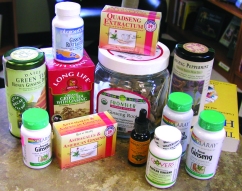Ginseng
Ecology and Cultivation Potential of American Ginseng
American ginseng (Panax quinquefolius L.) is a long-lived perennial that is rare throughout its native range of eastern and central North America, and is becoming rarer, likely due to over harvesting and excessive deer browsing, leading to a reduction of its preferred habitat. It is a valuable forest crop, highly sought by root diggers in Missouri since the 1850's and frequently poached from protected lands.

|
While ginseng can be commercially farmed, cultivated roots have a very different appearance than those that have grown "wild" in the forest. The wild root is highly prized by the Asian market, and brings a much higher market price than the cultivated root: $125 to $500 per dried pound for wild roots versus $6 to $12 for cultivated roots. Exports of wild American ginseng from the U.S. in 2001 totaled $59 million.
An alternative to growing ginseng under intensive cultivation is to grow wild simulated ginseng, which is ginseng sown in forest habitat and left to grow naturally. Ginseng grown in this manner is generally indistinguishable from truly wild ginseng, and can command an equally high market price. Wild simulated ginseng can be a potentially lucrative additional cash crop for landowners managing rich slopes for timber production.
To aid Missouri landowners in choosing appropriate locations for sowing ginseng, Center for Agroforestry collaborative researchers are studying the ecological characteristics of ginseng in the Ozark Highlands of Missouri. Nineteen naturally growing populations of ginseng have been identified in 13 counties, with measurement data reflecting the basal area, species composition of the trees present and the degree of canopy shading. Herbaceous plants growing with the ginseng have been identified to determine which are be the best indicators of successful ginseng growing sites.
Using data collected through soil samples at each site and seed germination trials, UMCA researchers will produce a grower's guide for Missouri to assist landowners in choosing appropriate locations for sowing and cultivating ginseng.
Key Findings, American Ginseng Research:
Through seed germination trials in 4 Missouri counties over 2 growing seasons, researchers
found that seed sown at a depth of 1 to 3 cm (approximately ½"-1¼ ") germinates more readily
than seed sown deeper, or seed merely sown on the surface of the soil.
Research has documented the long-noticed but seldom proven characteristic of a ginseng plant to remain completely dormant for one or more seasons. In a given year, an average of 2.5% of the study's ginseng population will not emerge at all, remaining dormant for as long as three years.
In following these slow-growing plants for eight years, only 16 of the 252 seedlings observed have reached reproductive size. It took an average of 4.4 years for these plants to reach this stage, producing only a few seeds each -- and none have become large reproductive plants. This information may be helpful in establishing harvesting guidelines.
Source: MS Thesis. Susan Farrington. Completed January 2006. An Ecological study of American ginseng (Panax quinquefolius L.) in the Missouri Ozark Highlands: Effects of herbivory and harvest, ecological characterization and wild simulated cultivation. 175 pp
Additional Research/Publications:
Effects of deer herbivory on population dynamics of American ginseng
MS Thesis. Susan Farrington. Completed January 2006. An Ecological study of American ginseng (Panax quinquefolius L.) in the Missouri Ozark Highlands: Effects of herbivory and harvest, ecological characterization and wild simulated cultivation. 175 pp

